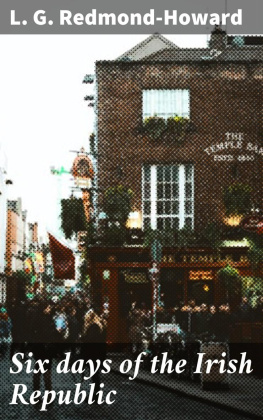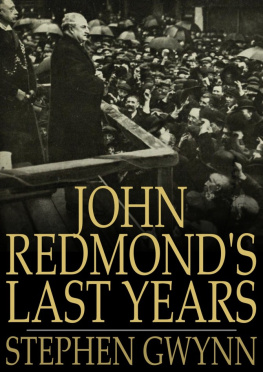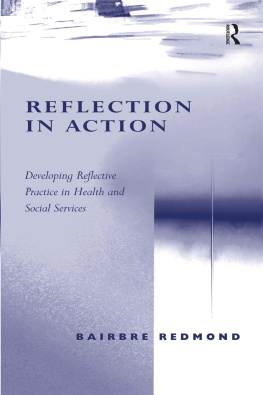J OHN R EDMOND
T HE N ATIONAL L EADER
D ERMOT M ELEADY
For Daragh
and
for Kate, Maeve, Conor and Jane
First published in 2013 by Merrion
an imprint of Irish Academic Press
8 Chapel Lane
Sallins
Co. Kildare
Ireland
2013 Dermot Meleady
British Library Cataloguing in Publication Data
An entry can be found on request
978-1-908928-31-3 (cloth)
978-1-908928-40-5 (e-book)
Library of Congress Cataloging in Publication Data
An entry can be found on request
All rights reserved. Without limiting the rights under copyright reserved alone, no part of this publication may be reproduced, stored in or introduced into a retrieval system, or transmitted, in any form or by any means (electronic, mechanical, photocopying, recording or otherwise) without the prior written permission of both the copyright owner and the above publisher of this book.
Printed in Ireland by SPRINT-print Ltd
L IST OF P LATES
The Half-Way Horse: political cartoon (Punch, 3 October 1906).
Reproduced with permission of Punch Limited,www.punch.co.uk
3(a) Aughavanagh Barracks, Co. Wicklow, in 1908.
Courtesy Redmond family private collection.
3(b) Redmond at leisure with setter, gun and cigar at Aughavanagh.
Courtesy National Library of Ireland.
Redmonds Concession: political cartoon (Punch, 22 December 1909).
Reproduced with permission of Punch Limited,www.punch.co.uk.
The Irony of Circumstance: political cartoon (Punch, 2 February 1910).
Reproduced with permission of Punch Limited,www.punch.co.uk.
6(a) Redmond on horseback at Aughavanagh.
Courtesy Redmond family private collection.
6(b) Redmond with Pat OBrien MP at Aughavanagh.
Courtesy National Library of Ireland.
Redmondus Rex: political cartoon (Punch, 1 May 1912).
Reproduced with permission of Punch Limited,www.punch.co.uk.
Second Thoughts: political cartoon (Punch, 8 October 1913).
Reproduced with permission of Punch Limited , www.punch.co.uk.
Redmond and Dillon leaving Buckingham Palace during the abortive Conference with the Ulster Unionist and British leaders, July 1914.
Courtesy National Library of Ireland.
12(b) British Army recruiting poster quoting Redmond speech 1915.
Courtesy National Library of Ireland.
The Golden Moment: political cartoon (Punch, 24 May 1916).
Reproduced with permission of Punch Limited,www.punch.co.uk
14(a) At Aughavanagh circa 1915 (from left): William Archer (Billie) Redmond MP, unidentified woman, John and Amy Redmond, Pat OBrien MP.
Courtesy Redmond family private collection.
14(b) John Redmond: studio portrait 1918.
Courtesy Redmond family private collection.
16(a) Andrew Bonar Law MP (left) and Sir Edward Carson MP.
Courtesy National Library of Ireland.
A CKNOWLEDGEMENTS
I wish to thank Dr Mary Green, London, great-granddaughter of John Redmond, for providing me with access to her private collection of Redmond family correspondence, photographs and newspaper cuttings, and for her kind permission to reproduce several of these photographs in this book. I am also grateful to her brother John Redmond Green for giving generously of his time in providing me with copies of photographs, letters and newspaper cartoons from the private family collection, as well as for making me aware of the account in Rudyard Kiplings history of the Irish Guards of the action in which Redmonds son, William Archer Redmond, won the Distinguished Service Order.
I am also indebted to Peter Leppard for drawing my attention to the Aughavanagh Visitors Book, in the possession of Dr Mary Green, and for his generosity in providing me with a copy of his transcription of the entries.
I am grateful to Charles Lysaght for drawing my attention to the speech of John Redmond at the Oxford Union on 6 June 1907 and to his own commemorative article Our political debt to John Redmond is largely unpaid in The Irish Times of 1 September 2006, the 150 th anniversary of Redmonds birth.
It was a pleasure to meet Helen McIlwain of New York, the youngest child of Dr William T. Power, whose first wife was Esther Redmond, John Redmonds eldest daughter. I thank her for giving me a full account of Redmonds American descendants through Esther, and of the families and Irish antecedents of her own father and mother.
I wish to thank James and Sylvia OConnor, of M.J. OConnor Solicitors, formerly of Georges St., Wexford, for giving me access to the correspondence regarding the sale of the Redmond estate held in their office, and Tom Menton, formerly of OKeeffe and Lynch, Solicitors (now OKeeffe, Moore and Woodcock, Solicitors) for giving me access to his collection of Redmonds correspondence relating to Freemans Journal affairs.
As with the preparation of the first volume of this biography, Redmond: the Parnellite (2008), I remain in debt to Mary and Jamie Ryan, Ballytrent House, Co. Wexford and to Jarlath Glynn, Wexford Library, for helping me to understand the Wexford roots of the Redmond family. My thanks are also due to the directors, librarians, keepers and staffs of the National Library of Ireland, the National Archives, the manuscript library of Trinity College Dublin, the Bodleian Library, Oxford, the Parliamentary Archives, Westminster, the Public Record Office of Northern Ireland and the Dublin Diocesan Archives for their patience and courtesy.
Dermot Meleady, August 2013
A BBREVIATIONS
RP John Redmond Papers, National Library of Ireland, Dublin
DP John Dillon Papers, Trinity College Library, Dublin
OBP William OBrien Papers, National Library of Ireland, Dublin
AP Herbert Henry Asquith Papers, Bodleian Library, Oxford
BLP Andrew Bonar Law Papers, Parliamentary Archives, Westminster
LGP David Lloyd George Papers, Parliamentary Archives, Westminster
WP Archbishop William Walsh Papers, Dublin Diocesan Archives
NAI National Archives of Ireland
CBS Crime Branch Special
I.D.I. Irish Daily Independent and Daily Nation until 31 Dec. 1904 (abbreviated in the text to the Independent)
I.I. Irish Independent from 2 Jan. 1905 (abbreviated in the text to the Independent)
F.J. Freemans Journal (abbreviated in the text to the Freeman)
I.T. The Irish Times
N.W. Northern Whig
B.N. Belfast Newsletter
I NTRODUCTION
Redmond possessed elements of statesmanship of a high order. The fact that he was given no chance to apply his qualities in the rebuilding of his native land is one of the myriad tragedies of Irish history.
David Lloyd George, War Memoirs: Volume 1 (London, 1938), p.420.
I n October 1908, the Irish Parliamentary Party held a banquet at the Gresham Hotel, Dublin for its leader John Redmond and three colleagues on their return from a mission to the United States. His deputy, John Dillon, paying tribute to Redmond, said that he had effected one of the greatest works of conciliation ever wrought for Ireland a task that, I must confess, many of us doubted whether it was within the power of mankind to achieve. The reference was to one of Redmonds foremost achievements since assuming the chairmanship in 1900: his binding up of the wounds of the party after the decade-long Parnell split and his refashioning of it as an effective political instrument for nationalist Irish purposes in the UK Parliament. The partys reunification was a fragile affair: a fresh division had been patched up at the start of 1908, and would erupt again during the following year. Nevertheless, despite his having led the minority Parnellite faction for nine years after Parnells death, Redmond had been able to win the loyalty and affection of the former anti-Parnellite majority, chief among them Dillon. His success owed much to a rigorous application to work and to magnificently persuasive oratorical powers, but was due above all to what Dillon called the tact, the kindness, and infinite conciliatory power of Mr Redmond a personal style very different from the imperiousness of Parnell that had incubated enmities even as it ensured party discipline.








